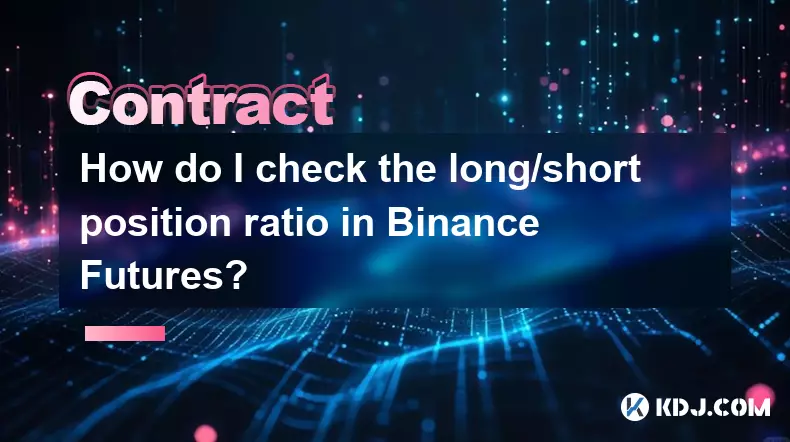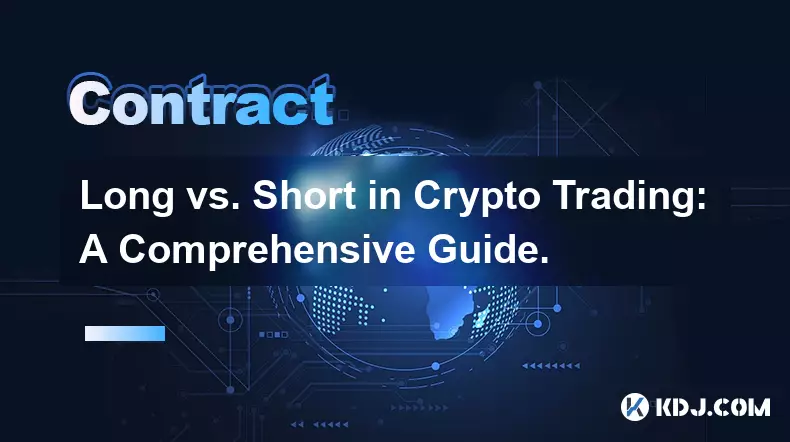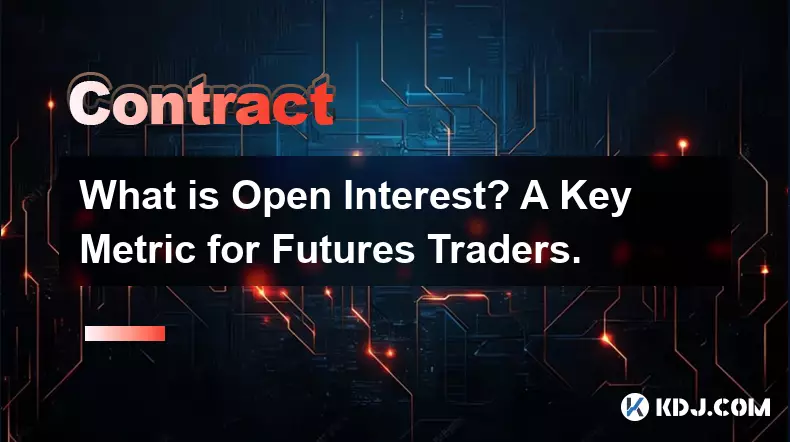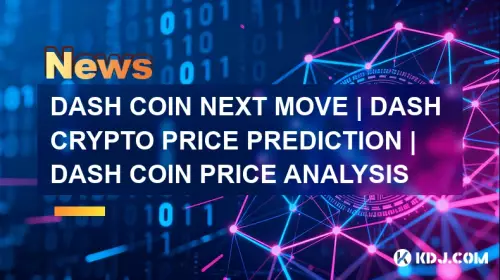-
 bitcoin
bitcoin $107015.826941 USD
-2.18% -
 ethereum
ethereum $3637.352324 USD
-5.18% -
 tether
tether $0.999831 USD
-0.02% -
 xrp
xrp $2.338078 USD
-6.23% -
 bnb
bnb $998.272150 USD
-6.97% -
 solana
solana $167.598257 USD
-10.12% -
 usd-coin
usd-coin $0.999863 USD
0.01% -
 tron
tron $0.282573 USD
-5.09% -
 dogecoin
dogecoin $0.169891 USD
-7.39% -
 cardano
cardano $0.557554 USD
-7.03% -
 hyperliquid
hyperliquid $39.914802 USD
-5.85% -
 chainlink
chainlink $15.414549 USD
-9.97% -
 bitcoin-cash
bitcoin-cash $510.361911 USD
-4.26% -
 ethena-usde
ethena-usde $0.999194 USD
-0.03% -
 stellar
stellar $0.282092 USD
-6.07%
How do I check the long/short position ratio in Binance Futures?
The long/short ratio on Binance Futures reveals market sentiment by showing the balance between bullish and bearish positions, helping traders spot trends and potential reversals.
Sep 19, 2025 at 07:36 am

Understanding the Long/Short Position Ratio in Binance Futures
The long/short position ratio is a key metric used by traders to gauge market sentiment in Binance Futures. This ratio reflects the proportion of long positions (bullish bets) to short positions (bearish bets) held by traders across various contracts. A higher ratio indicates more traders are betting on price increases, while a lower ratio suggests bearish dominance.
Accessing the Ratio via Binance App or Website
- Log into your Binance account and navigate to the Futures trading section.
- Select the specific futures contract you are analyzing, such as BTCUSDT or ETHUSDT.
- Look for the “Market Data” panel typically located on the right-hand side of the trading interface.
- Within this panel, locate the “Long/Short Ratio” section, which displays both the overall ratio and trader distribution.
- The data may also include separate ratios for top traders and all traders, offering deeper insight into institutional versus retail sentiment.
Interpreting the Data Accurately
- A long/short ratio above 1.0 means more open long positions than short positions in the market.
- A ratio below 1.0 indicates that short positions dominate, often interpreted as bearish sentiment.
- Sudden spikes or drops in the ratio can signal potential reversals, especially when diverging from price action.
- Comparing the ratio between large traders and small traders helps identify whether whales are positioning differently from the crowd.
- Extreme values in the ratio—such as readings above 3.0 or below 0.3—can suggest overbought or oversold conditions, respectively.
Using Third-Party Tools and APIs
- Some traders prefer external analytics platforms like Coinglass or Bybt, which aggregate Binance data and offer enhanced visualizations.
- These platforms often provide historical charts of the long/short ratio, allowing for trend analysis over time.
- Binance’s public API enables developers to fetch the long/short ratio programmatically using endpoints like /futures/data/globalLongShortAccountRatio.
- Custom bots or dashboards can be built to monitor real-time shifts in sentiment across multiple assets simultaneously.
- API access allows for automated alerts when the ratio crosses predefined thresholds, supporting proactive risk management.
Frequently Asked Questions
What does a long/short ratio of 2:1 mean?It means there are twice as many open long positions as short positions in the selected market. This generally reflects bullish sentiment among traders.
Can the long/short ratio predict price movements?While not a direct predictor, extreme ratios often precede reversals. For example, excessive longs may lead to liquidation cascades if the market turns downward.
Is the ratio available for all futures pairs on Binance?Yes, the long/short ratio is available for all USDT-margined and coin-margined futures contracts listed on Binance Futures.
How frequently is the long/short ratio updated?Binance updates the ratio every 5 to 15 minutes depending on server load and network activity, ensuring near real-time accuracy for active traders.
Disclaimer:info@kdj.com
The information provided is not trading advice. kdj.com does not assume any responsibility for any investments made based on the information provided in this article. Cryptocurrencies are highly volatile and it is highly recommended that you invest with caution after thorough research!
If you believe that the content used on this website infringes your copyright, please contact us immediately (info@kdj.com) and we will delete it promptly.
- MEXC, USDf, and Trading Volume: A Deep Dive into Recent Developments
- 2025-11-04 19:15:01
- Bitcoin, Crypto, and EcoYield Bonus: Is This the Smartest Play Now?
- 2025-11-04 19:15:12
- Cardano (ADA) and Altcoin Growth: Navigating the Landscape
- 2025-11-04 19:15:12
- XRP ETF Buzz: Is a Price Surge on the Horizon?
- 2025-11-04 19:20:01
- Binance, Stablecoins, and Liquidity: Decoding the Crypto Market's Next Move
- 2025-11-04 19:30:01
- Milk Mocha's $HUGS: The Presale Meme Coin Redefining Community and Value
- 2025-11-04 17:50:02
Related knowledge

Long vs. Short in Crypto Trading: A Comprehensive Guide.
Nov 04,2025 at 07:39pm
Understanding Long and Short Positions in Cryptocurrency Markets1. In crypto trading, taking a long position means buying a cryptocurrency with the ex...

The 2025 Guide to Profitable Crypto Futures and Derivatives Trading.
Nov 01,2025 at 07:39pm
Understanding Crypto Futures and Derivatives in 20251. Crypto futures are financial contracts obligating the buyer to purchase, or the seller to sell,...

Navigating a Bear Market: Shorting Strategies for Crypto Futures.
Nov 03,2025 at 07:18pm
Understanding Bear Market Dynamics in Crypto1. A bear market in the cryptocurrency space is characterized by prolonged price declines, often driven by...

What is Open Interest? A Key Metric for Futures Traders.
Nov 03,2025 at 11:18pm
Understanding Open Interest in Cryptocurrency Futures1. Open interest refers to the total number of active futures contracts that have not been settle...

Identifying Support and Resistance Levels for Crypto Contract Trading.
Nov 04,2025 at 06:15pm
Understanding Support and Resistance in Crypto Markets1. Support and resistance levels are foundational concepts in technical analysis, especially wit...

A Deep Dive into Market Orders vs. Limit Orders for Futures.
Nov 02,2025 at 10:19pm
Understanding Market Orders in Futures Trading1. A market order is an instruction to buy or sell a futures contract immediately at the best available ...

Long vs. Short in Crypto Trading: A Comprehensive Guide.
Nov 04,2025 at 07:39pm
Understanding Long and Short Positions in Cryptocurrency Markets1. In crypto trading, taking a long position means buying a cryptocurrency with the ex...

The 2025 Guide to Profitable Crypto Futures and Derivatives Trading.
Nov 01,2025 at 07:39pm
Understanding Crypto Futures and Derivatives in 20251. Crypto futures are financial contracts obligating the buyer to purchase, or the seller to sell,...

Navigating a Bear Market: Shorting Strategies for Crypto Futures.
Nov 03,2025 at 07:18pm
Understanding Bear Market Dynamics in Crypto1. A bear market in the cryptocurrency space is characterized by prolonged price declines, often driven by...

What is Open Interest? A Key Metric for Futures Traders.
Nov 03,2025 at 11:18pm
Understanding Open Interest in Cryptocurrency Futures1. Open interest refers to the total number of active futures contracts that have not been settle...

Identifying Support and Resistance Levels for Crypto Contract Trading.
Nov 04,2025 at 06:15pm
Understanding Support and Resistance in Crypto Markets1. Support and resistance levels are foundational concepts in technical analysis, especially wit...

A Deep Dive into Market Orders vs. Limit Orders for Futures.
Nov 02,2025 at 10:19pm
Understanding Market Orders in Futures Trading1. A market order is an instruction to buy or sell a futures contract immediately at the best available ...
See all articles










































































